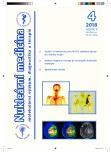Central venous catheter mimicking metastasis on a bone scan – advantage of a hybrid imaging
Authors:
Viera Rousková 1; Otto Lang 2
Authors‘ workplace:
Oddělení nukleární medicíny, ON Trutnov a. s., ČR
1; Oddělení nukleární medicíny, ON Příbram a. s., ČR
2
Published in:
NuklMed 2018;7:74-75
Category:
Overview
66-y-old lady was sent to our department for a bone scan as a part of an investigation of a tumor of unknown origin. She cooperated; she was afebrile, without dyspnea or icterus. She suffered from dysorexia but she did not loss her weight. She had a hypertension; diabetes compensated with oral antidiabetics; and hypothyroidism compensated with a treatment. Her oncological history was negative. Basic physical
examination was normal except obesity. Chest X-ray was negative, abdominal sonography suspected liver cirrhosis with an ascites, proved cholecystolithiasis. Gastroscopy detected hiatal hernia and ulcer on the large curvature with mucosal
infiltration but histology was negative regarding a tumor. Gynaecological work-up including sonography was also negative. Central venous catheter into the right subclavian vein was inserted due to an obesity and a poor venous access.
Whole-body bone scan was performed routinely 3 hours after injection of 800 MBq of 99mTc-HDP on a gamma camera BrightView XCT (Philips). Radiopharmaceutical was administered into the catheter which was flushed with 20 ml of normal saline before and after injection. Focally increased accumulation in the right sternoclavicular joint and in the dorsal right 5th rib paravertebrally was detected except of physiological accumulation in the bone tissue of an axial skeleton and large joints. (Fig. 1) We performed a SPECT/CT of the thorax for better specification. (Fig. 2) The focally increased accumulation was evident near the end of the catheter; no accumulation was detected in the sternoclavicular joint or in the right 5th rib; these foci were detected due to shining through to the detectors only. We concluded that the bone scan is physiological without signs of metastases. Renal failure with a mineral breakup progressively occurred and the patient died under the picture or a cardiopulmonary failure 4 weeks after an admission. Primary tumor was not detected, oncological therapy was not provided.
Key words:
bone scan, extraosseous accumulation, catheter, SPECT/CT
Sources
- Soundararajan R, Naswa N, Sharma P et al: SPECT-CT for characterization of extraosseous uptake of 99mTc-methylene diphosphonate on bone scintigraphy. Diagn Interv Radiol 2013; 19 : 405-410
- Zadražil L, Libus P. Specifikace nejistých lézí na planární celotělové kostní scintigrafii s použitím SPECT/CT u onkologických pacientů. NuklMed 2013;2 : 25-30
- Wilbur MJ, Gagliardi JA, Riccio GJ, et al. Soft tissue uptake in radionuclide musculoskeletal imaging. Applied Radiology 1997; 26 : 30–37
- Zuckier ZS, Patel KA, Wexler JP et al. The hot clot sign. A new finding in deep venous thrombosis on bone scintigraphy. Clin Nucl Med 1990;15 : 790-793
- Ravizzini G, Nguyen M, Schuster DM et al. Central Line Injection Artifact Simulating Paratracheal Adenopathy on FDG PET Imaging. Clin Nucl Med 2004;29 : 735–737
- Haire WD, Lynch TG, Lieberman RP et al. Duplex scans before subclavian vein catheterization predict unsuccessful catheter placement. Arch Surg 1992;127 : 229-230
- Becherer A, Mentes M, Leitha T. Tracer retention in a central venous catheter. Clin Nucl Med 1998;23 : 45-46
- Eftekhari M, Gholamrezanezhad A. Unusual misplacement of a subclavian vein catheter detected on a bone scan. Rev Esp Med Nucl. 2006;25(2):117
- Shinoda K, Taki H, Hounoki H et al. Accidental Cannulation of a Femoral Central Venous Catheter Into the Iliolumbar Vein Incidental Detection by Bone Scintigraphy. Clin Nucl Med 2015;40 : 182Y183
- Spencer R, Karimeddini M. Introduction of bone imaging agent into the pleural space. Clin Nucl Med 1986;11 : 290
Labels
Nuclear medicine Radiodiagnostics RadiotherapyArticle was published in
Nuclear Medicine

2018 Issue 4
Most read in this issue
- Assessment of 11C-methionine for PET/CT examination of patients with a brain tumor – group of 16 patients
- Detection of Paget´s disease during labeled leukocytes scintigraphy – case report
- Central venous catheter mimicking metastasis on a bone scan – advantage of a hybrid imaging
